 |
||
|
||
| ||
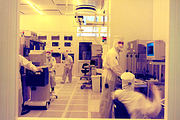 The last month was full enough with technological initiatives and epochal events in the semiconductor industry, such as the merger of Hewlett-Packard and Compaq, the beginning of the mass appearance of Pentium 4 platform components supporting 533 MHz FSB, the launch of the world-first 5th-generation LCD panel fab. The next month, June, starts with the grand industry breakthrough show, May being the preparation. So, it was pleasant to watch industry getting better. Production, technologies, equipmentRecently we've been seeing triumphal releases about launching test installations for 0.09-micron chip production, building fabs and constructing tools for them. It sometime seems that the previous 0.13-micron process has lost the large part of its actuality.. Well, it's not so of course. Let's not forget that the real mass 0.13-micron production on Intel's capacities has been launched just recently at the end of the last year. Many companies now try hard to launch their own new production lines, some of them making 0.13-micron chips in limited amounts. Nevertheless, I assume that the introduction of this technology can be solved in enough time and R&D expenses. So, the most important factor is the ability to earn money now to invest them into manufacture and be up-to-date. It's pleasant to see the microelectronic industry getting better. Just take the growth of the new equipment orders amount. According to the report of Semiconductor Equipment and Materials International (SEMI), chip production market observer, April orders volume made $982 million, exceeding that of March ($836 million) by 17%. The growth made 36% comparing to April last year ($721 million). SEMI has been reporting the orders volume growth for the fifth month already. This is a background for messages from different manufacturers about increasing capital development expenses already in 2002. According to Semiconductor Industry Association (SIA), the current sales forecast for 2002 makes $150 billion (vs. $139 billion of 2001). This can be easily exceeded by the end of the year, taking into account the current situation. Chip production tools makers cheered up a little. We've been hearing dull reports of hardly surviving industry unready to modern tools purchase for the entire first quarter. Now analysts believe the situation is changing greatly, the radical turn to happen at the year-end. ASML plans to deliver about 70-80 tools in the first half-year of 2002, and up to 100-110 units in the second. Currently ASML works with IBM, Intel, Micron, Motorola, Philips, STMicroelectronics, TSMC, and UMC. In May ASML reported the heavy order for over $176 million from "a Taiwanese company", most likely TSMC. By the way, despite the reduction of delivered tools amount, their average price constantly increases along with the increasing orders for newer and more expensive 248 nm and 193 nm tools. The average price of such unit makes about $10 million. It's pleasant that the high-end market, including 300 mm wafers production, orders 80% of them. So, this year ASML can be profitable or at least compensated. Nikon, being the leader of lithographic equipment industry, has some worse business. In May it reported the ¥3.6 billion (about $270 million) fiscal year profit, that's 91% worse than the last year. The new 2003 fiscal year, which began on the 1st of April 2002, might be unprofitable to Nikon. Nikon's lithographic equipment deliveries decreased to 250 in 2002 from 407 in the 2001 fiscal year. According to provisional data, only 220 units are to be sold in the 2003 fiscal year. The amount of LCD production tools, sold by the company is also decreasing: 69 units in 2001, 62 in 2002, and only 35 LCD scanners forecasted to 2003. Nikon representatives allege the hard times of industry, though the company's sales volume was affected due to surprising activity of the third largest lithographic vendor - Canon. However, the 2004 fiscal year, according to Nikon's specialists, will be successful enough for the company, as the deliveries of chip production tools will exceed the 2003 year values by about 30-40%, LCD scanner deliveries exceeding even more: by 50%. But Nikon feels confident enough supported by its most important customer. In May Intel reported the intention to purchase Nikon's new convertible bonds for ¥10 billion ($80 million), that can be further exchanged for 1.36% of Nikon's shares, and also plans for the future cooperation in the development of optical lithography tools for 90 and 65 nm chip production. Despite the triumph of ASML, announced the order from Intel for the EUV tools delivery by 2005, Nikon isn't going to lose and is now developing several prospective lithographic technologies at once, including 157 nm scanners with calcium fluoride (F2) and 13.5 nm EUV tools. The samples, according to the company, will be ready already in 2004. So, the battle for customers is going to take place at that time. Now something about 157 nm lithography. In May Sematech reported the changes in the development of such tools. The main problem of the company was the inner brieringering in CaF2 crystals primarily used for lens production. The first step to solve the problem was the creation of annealed crystals meeting the homogenic and brieringering requirements at applied strain. Now this is almost solved. The next step on the way to 157 nm lithography is to solve soft photomasks problems. Now the selection of adequately transparent polymers is rather slow. Perhaps, they'll have to use harder materials for making photomasks. Anyway Sematech is sure that 157 nm lithography is to be soon ready for the "mass utilization" so to say. "Soon", of course, means when chip semiconductors become as small as 0.065 micron. May also brought us some coalitions. I guess the most remarkable was the announce from Infineon, AMD, and Dupont Photomasks about a joint-venture for developing and making new photomasks, quartz and glass substrates for semiconductors on the new fab in Dresden, Germany. Infineon has also reported the cancellation of its photomask development project in its Munich center. The fab construction is to finish in the beginning of 2003, the mass production is to start in the second half-year of 2003, the project will cost the partners ˆ360 million ($329 million). It's interesting that alliance members pursue very different objects. While Infineon is going to use fab production for making new communication devices and memory chips, AMD will use it for new processors. Dupont Photomasks has even clearer aims: it signed a multimillion 10-year contract with Infineon to become its general photomask supplier. One of the current unordinary projects continued in the last month: Isonics reported the deliveries of the first SOI (silicon-on-insulator) wafers, made of isotopic clean Si-28, to an unnamed "leading processor maker". Despite the concealment of the customer's name, we remember that AMD was declared the potential customer of such products a year ago. Hereon... it's silent. Perhaps we'll know of the experiment results if they are positive. I.e. in case the chips made of isotopic clean wafers will feature considerably better heat-conducting characteristics than "usual" ones.  Two events of May continued the development of industry-important new-generation bus specs. In the beginning of the month PCI Special Interest Group announced the program of North American PCI-SIG Developers Conference 2002 to take place in the very beginning of June. At it PCI-SIG will present the documentation and complete specs of the PCI bus version 2.3 along with the newest developments, such as PCI Hot-Plug. The theme of the conference will be the PCI Express (former 3GIO) and PCI-X 2.0 specifications - the two new I/O interfaces, which docs are now being taken to 60-day examination by PCI-SIG members. Besides, HyperTransport Technology Consortium, created for the development and promotion of HyperTransport bus standard specifications, announced the set of additional communications features for HyperTransport in high-speed network and communication apps as a network processor bus.  The HyperTransport communication set includes an additional message passing protocol for larger packet sizes, error recovery protocol, 64-bit addressing support, 16 additional streaming and dedicated virtual channels for parallel data transfer optimization, standardized HyperTransport switching functions and peer-to-peer direct transfer protocol. The final specifications of Networking Extensions for HyperTransport will be published in the second half-year of 2002. The merger of Hewlett-Packard and Compaq Computer and forming of the new Hewlett-Packard company became the most important industry event. In two days after the merger Hewlett-Packard officially announced the future plans of product promotion under the new HP brand. The company has generally selected the most popular brands for the combined product lines. Read more about it in our editorial "The new Hewlett-Packard: changing product lines after the merger with Compaq Computer". And currently the main result is that the new Hewlett-Packard became the world-first among the manufacturers of Windows and UNIX servers, enterprise data storage systems, printing and digital photo editing devices, PCs and enterprise IT management software. So, many had to move aside the leading places... ProcessorsMay brought straight-forward news of Intel: one processor after another, new 533 MHz FSB chipsets, new initiatives. Future was discussed as well, but it was pleasant to see new products besides just hearing about the plans. In the very beginning of the month Intel announced the release of long-awaited Pentium 4 CPUs, featuring 2.53, 2.40, and 2.26 GHz, supporting 533 MHz FSB, 512 Kb L2 cache. They are made according to the 0.13 micron technology and released both as retail and OEM packages. 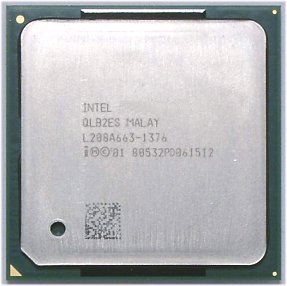 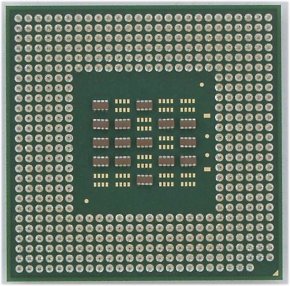 I'd just like to add that these novelties were paper-and-pencil, at least 2.40 and 2.26 GHz Pentium 4 could be seen in many shops in the end of the month; and their release dragged prices for previous models deeper down. Intel's next step was to release new chips based on Pentium 4 (Willamette) named Intel Pentium 4 Celeron. 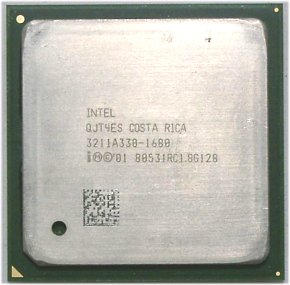 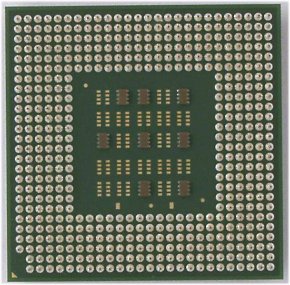 Unlike the "old" Celeron based on Pentium III architecture supporting just 100 MHz FSB, the new processors support 400 MHz FSB and feature up to 1.40 GHz clock rate. From the other hand Pentium 4 Celeron has only 128 KBytes L2 cache although the latest Socket 370 Celeron with the Tualatin core had 256 KBytes L2 cache. Pentium 4 Celeron support SSE2 instruction set and have mPGA478 packaging. It couldn't happen without any misunderstandings. Only 1.70 GHz models were presented on the announce day, but now most vendor offer another, senior model featuring 1.80 GHz clock rate (we had both of them for testing). There's not a clear destiny of Pentium 4 Celeron CPUs and their life cycle. Many analysts believe these chips to be rather popular in the budget PC market along with new i845G/i845GL/i845GLL motherboards. But, perhaps, they won't be as recognized as their Socket 370 "namesake" from the enterprise PC market. The "old" 1.4 GHz Celeron Socket 370 debuted the same day almost unnoticed. 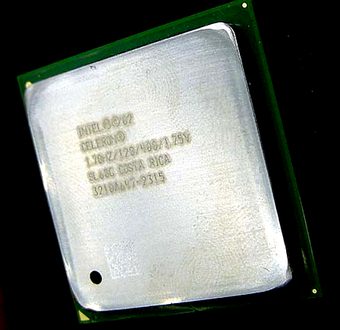 1.40 GHz Socket 370 Celeron is a logical continuation of the standard FC-PGA2 line with a traditional 100 MHz multiplier. It's made according to the 0.13 micron technology (Tualatin core), has 256 KBytes L2 cache, 100 MHz FSB, 1.5 core supply voltage, 34.8 W dissipated power (the previous 1.3 GHz model features 33.4 W dissipated power). AMD "peacefully" passed May, having not announced. Industry repeatedly rumours that the first desktop Athlon XP with Thoroughbred core will be announced on the 10th of June. On that day we expect the Athlon XP 2200+ (1.8 GHz) CPU. The Athlon XP 1700+ - Athlon XP 2100+ line (1.47-1.73 GHz) will also be moved to the Thoroughbred core. The new Thoroughbred-based processors won't differ from their predecessors by anything except for the new 0.13 micron technology and, so the core size: new Athlon XP Thoroughbred will be 80 sq. mm (vs. 128 sq. mm of the current Palomino). Perhaps, due to the release of newer 0.13 micron models, AMD won't release 2200+ based on Palomino. Anyway, it's up to the next month. I'll just mention AMD's message on the continuation of Socket A platform life cycle until 2004, to move it to the Low-End afterwards. It might happen when the quantity of 64-bit Hammer systems on the market will reach some critical level. AMD's prospective processor roadmap has seriously changed. Appaloosa CPUs won't see the light at all, being removed from roadmap. Athlon will continue to slowly migrate to lower-ends, giving room for the Hammer family. This is the main strategy of AMD for the nearest future. Besides, it has been officially proved that Barton-based processors will have 512 KBytes L2 cache. 32-bit Athlon CPUs won't be ever supporting 166 FSB not to become rivals for Hammer. In the end of the month AMD followed Intel to reduce the official wholesale prices. The reduction made 52% for some CPU models. Analysts explain this quick spring decrease that already now many system builders are preparing for the "back-to-school" season. In other words, many are now buying things to sell in August-September. Transmeta "gets on" rather humbly, but with dignity. According to Phillip Bergman, Transmeta communication department director, now the company's balance makes more than $200 million in cash and other assets. Some income growth in the 1st quarter of 2002 strengthened company position, comparing to the last quarter of 2001, due to the long-postponed, but at last released Crusoe TM5800 processor. Transmeta awaits the about 55-65% income growth in the 2nd quarter of 2002, mainly due to the mass deliveries of Crusoe TM5800 processors. Despite some tarnished reputation because of Tam's delay of TM5800 release, Transmeta isn't going to change the production partner and apply to others, including UMC. Though considering all markets where its Crusoe line might occupy a niche, Transmeta doesn't plan to develop or make DSP or CPU for mobile phones. Its current strategy is actually declared in the announced initiative: "Crusoe 1000 - a mobile PC for $1000 (and less), featuring 1000 MHz (and higher) CPU, weighing 1000 gr (and less), independently working 1000 (and longer) minutes". Though periodicals already mentioned TM5800's messages regarding 1 GHz CPU, it hasn't been presented yet, to be officially announced, according to company representatives, in the nearest future. However, there's not only this chip announcement to be delayed: the release of a new prospective Crusoe TM6000 development with a built-in graphics core was moved to someday in 2003 from the end of 2002. 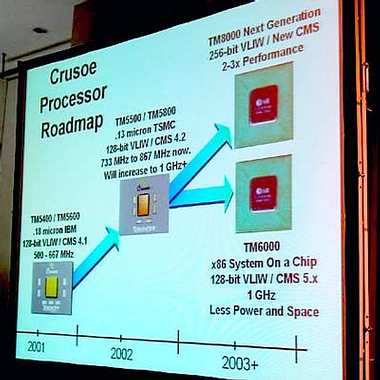 Still the company roadmap was updated with another processor model - Crusoe TM8000 - that like TM6000 is an integrated "system-on-a-chip" with the built-in 256-bit VLIW instruction handler. But TM8000 is also expected only in 2003. Systemboards and chipsetsIntel was unconditionally the first in this category. In the beginning of the month it presented the new 850E chipset, supporting 533/400 MHz and RDRAM memory, along with the new Pentium 4 CPUs, supporting FSB 533 MHz.  i850E (82850E MCH) has a 615-pin Organic Land Grid Array (OLGA) package and officially supports PC600/PC800 RIMM modules. Though many makers persistently underline the PC1066 RDRAM support, releasing motherboards on this chipset, it's not officially mentioned in specs. 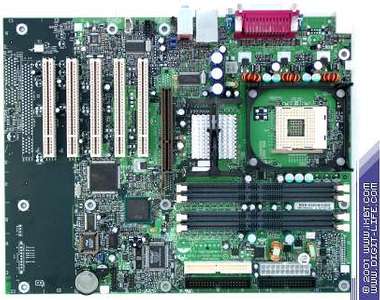 And, of course, Intel was the first to officially announce i850E motherboards. These were D850EMV2 and D850EMD2. IWILL followed it with the P4R533-N and ASUS - with the P4T533-C. The second half of May brought us three new Intel's DDR chipsets for Pentium 4 at once: i845E, i845G, and i845GL.  i845E 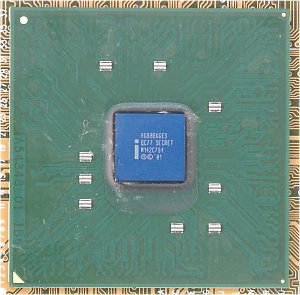 i845G i845E features the Intel MCH (Memory Controller Hub) i845E North bridge completed with ICH4 South bridge and represents a discrete version supporting 533 MHz FSB and DDR200/266 DDR SDRAM. i845G features the Intel GMCH i845G North bridge with integrated Intel Extreme Graphics and ICH4 South bridge; it's pin-compatible with the previous i845 line, and like i845E supports 533 MHz FSB and DDR200/266 memory; in addition it supports PC133 SDRAM. Video subsystem uses 8 MBytes buffer allocated from RAM, and the driver dynamically allocates up to 64 MBytes of additional memory, depending on the application. i845GL differs from i845G by lacking the external AGP bus support. 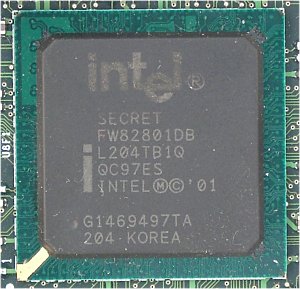 The good news was the announce of a new ICH4 South bridge (I/O Controller Hub) with built-in support of 6 USB 2.0 ports (EHCI); 20-bit audio interface, up to three codecs support, Dual DMA support for simultaneous output via PCM and S/PDIF. Intel has simultaneously started to deliver four new motherboards: D845GBV and D845EBG2 in ATX package, and also Intel D845GRG and D845EPT2 in micro-ATX package.  Other makers followed the leader. IWILL hit the news first, having presented P4E (i845E version) and P4G and mP4G (i845G versions; above); they were followed by i845E-based P4B533 from ASUS. Besides, IWILL integrated Serial ATA controllers into its boards. According to preliminary data, Intel will begin supporting DDR333 in September after discrete i845PE and integrated i845GE are released. These chips will be alike i845E and i845G, except DDR333 support and will feature the same ICH4 South bridge. Perhaps, the samples of i845PE and i845GE will be shown off in June at Computex Taipei 2002. VIA Technologies announced the support of 533 MHz FSB for Intel Pentium 4 along with the release of new VIA Apollo P4X266E chipset.  It's based on the current VIA Apollo P4X266A and is fully circuit-compatible with VIA Apollo P4X266 and P4X266A. Using VIA Apollo P4X266E with the VIA VT8235 South bridge results in the USB 2.0 support; using it with VIA VT8233A South bridge - in Ultra ATA/133 support. Taiwan rumours that VIA Apollo P4X266E sale price is $18, that's $15 less than the sale price of the one of Intel's most inexpensive chipsets - i845GL. It might be so that P4X266E will interest manufacturers and P4 market rivalry will proceed to the new phase, as SiS is also going to reduce the price of its 645, 645DX, 650, and 650GX Pentium 4 chipsets, currently costing $25-30. 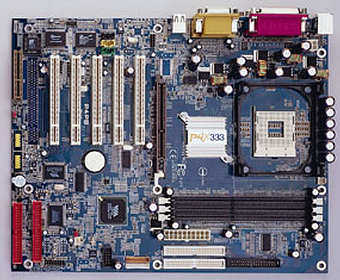 In May VIA presented the first and still the only Apollo P4X333 boards: P4PB (VT8233A South bridge) and P4PB Pro (VT8235 South bridge). They support 533/400 MHz FSB, DDR333 SDRAM, USB 2.0, 6-channel audio, Smart Card and Memory Stick cards. It's still unknown when other makers will release boards in this chipset. The situation might become clear at Computex 2002. It's not interesting to discuss motherboards and chipsets further: I'll have to insert "expected in June" or "to be shown at Computex 2002 in June" in a phrase. So, let's leave this to the next digest and talk about general tendencies of chipset production. As motherboard makers easily adopt new memory standards and processors, there's a clear tendency of equipping boards with all possible interfaces. LAN, USB 2.0, and Firewire ports, ATA133 interface became almost a usual thing of current boards. The next is to adopt Serial ATA 150, integrated ADSL controllers, wireless peripherals, both built-in, and add-in. there's no need to remind about the general enthusiasm of making barebone systems. 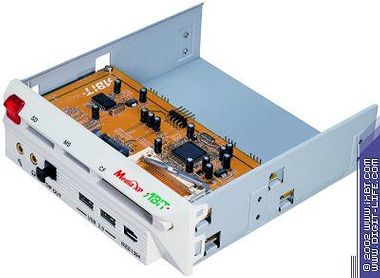 Many manufacturers equip their boards with additional external modules like Media XP from ABIT, featuring USB2.0, IEEE1394a ports, Plug-and-play drive supporting Compact Flash (CF I and II), Memory Stick, and Secure Digital; S/PDIF-Out supporting Mini Disk player output, Mic-In, headphones output, Dolby Digital/DTS support, and a remote control. Well, it's a clear attempt to interest buyers with board's extra capabilities in addition to the standard enough specs of their majority. Briefly about new market players. The new "straight-away" Taiwanese Albatron Technology, former Chun Yun Electronic, continues to extend its worldwide presence along with developing new products. In March it invested €1.5 million into its British subsidiary, and it has also been recently rumoured to create another in Germany. By the way Albatron already has branches in North America and Netherlands. The company has also reported to announce another partner for distribution in China soon. Albatron has been making consumer electronics before. As you remember it entered the motherboard market in the beginning of this year. However, it expects the sales volumes to grow by 2.3 times in the second half-year. The situation with another motherboard market newbie, Hua Ching, ASUSTeK subsidiary, became clearer as well. According to preliminary data, the mass deliveries of Hua Ching products is planned to the 3rd quarter of 2002. The first things will be presented in the end of June, announces to come one after another already in July-August. All Hua Ching capacities will be located in China in order to reduce cost prices and set an acceptable price level for the production. ASUS leaders believe Hua Ching to become profitable already in 2002 and achieve production volumes comparable to the majority of second echelon manufacturers - about 150 thousand boards per month. In the future ASUS is going to make high-end products, known to be highly profitable at the start. Besides planning to extend the market space due to the second brand, ASUS also aims at increasing OEM orders quantity, this being another reason of Hua Ching birth. When the volume of OEM orders are low, ASUS capacities won't be idle, releasing boards under the second brand. MemoryThe favourite theme of analysts is to guess when prices begin to go up. Some believe it to happen in the middle of summer, others think of the middle of the 3rd quarter. Remembering the last summer and DRAM market, having been hopeless until the fall 2001, I'd rather not to think about the PC market, overproduction and even the season factor, but remind of a power capable of reducing all other to zero. I suspect that all manufacturers cannot just agree about a unified market strategy like it was last year (let alone the antimonopoly methods, as makers can understand each other when possible): one try to "dip" others by low prices, others have to sell stocks for any price, hoping to get at least something. Actually it's far more serious, all factors are important and there are many reasons preventing makers from keeping older prices. But still, I guess it's the inability to come to an agreement that keeps market for from stable. During May prices for 128 Mbit DRAM chips reduced from $3 to $2 and lower - down to $1.50, and still are not going to roll back. Of course, the beginning of June/July purchases by system builders before August/September "back-to-school" season in this more "energetic" year might lead to market activity growth and to memory prices increase. Though this factor didn't do anything noticeable to prices last year. Bottoming the first five months of 2002, I'd like to mark than even the memory demand growth expected due to new i845E/i845G/i845GL chipsets release, hasn't justified hopes yet. Everybody waited for the remarkable RAM market growth, most distributors expanded stocks, hoping prices to go up in a while. But this "while" continued until May and then prices just collapsed. Of course, manufacturers might hope that the reduction of prices for Intel and AMD processors, announced in the end of May, along with the global upgrade of enterprise PC park will result in some activity boost. Nevertheless none expects serious prices growth before August. Meanwhile makers report the readiness to the mass production of newer specification chips. Samsung Electronics was the most fruitful in May, having announced the whole bunch of novelties. In the beginning of the month it reported the mass deliveries of 128 MBytes, 256 MB, and 512 MBytes DDR SDRAM (DDR400) modules. Company partners began receiving new 128 MBytes and 256 MBytes DDR400 PC3200 modules from Samsung in the very beginning of the month, and 512 MBytes DDR400 PC3200 modules - in the end of it. The next thing was the release of 256 Mbit Network-DRAM chips - high-speed memory for 10 GBytes Ethernet and OC-192 communication devices - fully compatible with FCRAM and developed together with Fujitsu and Toshiba. Network-DRAM is actually a market name for Samsung FCRAM family. TRC of Network-DRAM chips is 25 ns, that's 60% less than 60 ns of DDR333, Network-DRAM tRAC is 22 ns, that's 40% less than 35 ns of DDR333. They require 2.5 V, and the DDR SDRAM interface enables Network-DRAM to work at 200 MHz and provide up to 400 Mbit/s bandwidth. 256 Mbit Network-DRAM from Samsung are made in x8 and x16 configurations according to 0.15 micron technology in 66-pin TSOP2 packages. 256 Mbit Network-DRAM samples: K4C561638C (16 MBytes x 16) and K4C560838C (32 MBytes x 8) are already available, their mass production is expected in the third quarter of 2002. In the end of May Samsung at last announced the release of the industry-first 512 Mbit DDR-II SDRAM chips meeting the requirements of JEDEC DDR-II adopted in March 2002. Their features are as follows:
Currently the read/write speed of 512 Mbit Samsung chips is 533 Mbit/s, but the company states that it can be easily increased up to 667 Mbit/s for specific tasks, and networking in particular. The mass production of 512 Mbit DDR-II SDRAM chips is planned to the 3rd quarter of 2003. Perhaps, such samples will be presented by Samsung's rivals - Micron, Infineon, Japanese Elpida. TwinMOS Technologies announced the release of PC3200 samples on DDR400 chips. 256 MBytes and 512 MBytes samples of Unbuffered TwinMOS PC3200 DIMM modules will be presented at Taipei Computex 2002.  Besides, TwinMOS reported its full readiness for the mass production of such modules, having successfully finished qualification tests. PC3200 modules were tested with VIA KT400, SiS 645DX and SiS 648 based boards. New modules are made on TSOP II packaged chips, featuring standard 184-pins, require 2.5 V supply voltage. They'll possibly become available in large quantities in the 3rd quarter of 2002. It's worth mentioning some activity growth in the RDRAM sector. The plenty of May news are definitely provided by the Intel 850E chipset announcement. Rambus itself is optimistic to the mass-media. According to representatives, Rambus is ready to rumble for a place on the memory market even without Intel. Intel explains 1066 MHz RDRAM ratification delays by that it simply lacks time to adopt such a large number of modules and chips various standards. However, as the announcements show, 850E chipset unofficially supports 1066 MHz RDRAM nevertheless. Despite the delayed industry adoption of 1066 MHz RDRAM chips by Intel, Rambus assures everyone of a considerable industry breakthrough in making the new memory. Kingston and Transcend reported the release of PC800/PC1066 modules in May. Kingston started to deliver 16-bit 512 MBytes and 256 MBytes 800 MHz RIMM and 1066 MHz RIMM modules (on Toshiba 256 Mbit PC1066 RDRAM chips). The new 32-bit modules - the so-called PC4200 on Samsung chips - will appear later, according to the company. Transcend started to deliver 16-bit 40 ns 128 MBytes, 256 MBytes, and 512 MBytes PC800 RIMM modules along with 32 ns 256 MBytes PC1066 modules. Samsung, used to the top places, was the industry first to announce the release of samples of 32-bit dual-channel 64 MBytes, 128 MBytes, 256 MBytes, and 512 MBytes RDRAM RIMM4200 modules. 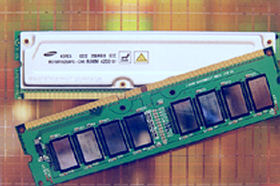 New dual-channel modules provide up to 4.2 GBytes/s of maximum bandwidth and, according to ASUSTeK, whose P4T533 board supports RIMM4200, their usage will not only improve the system performance, but also reduce PC cost price in general due to 4-layer circuitry for new dual-channel RDRAM modules. According to Samsung, it will launch the mass production of 0.13 micron 256 Mbit and 288 Mbit DRAM chips already before the first half-year ends. The next stage is to transit to 576 Mbit chip production. Most possibly, new 32-bit RIMM4200 modules from Samsung will appear on the market already in the 3rd quarter of 2002. Japanese Elpida, following the leader announced the release of samples of dual-channel 32-bit PC800 RDRAM modules, mass production to be launched in the 4th quarter. 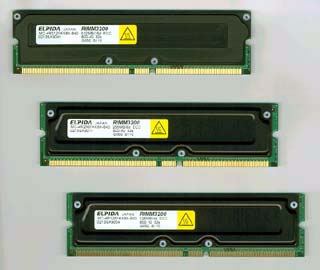 New 232-pin RIMM3200 modules have 400 MHz clock rate, tRAC = 40 ns, maximum transfer rate is 3.2 GBytes/s, ECC. They'll be made in 128 MBytes, 256, and 512 MBytes versions. The company has also announced the preparations for release of RIMM4200 modules, working at 1066 MHz. In the very beginning of May AMD, followed by its R&D partner - Fujitsu, announced the deliveries of MirrorBit Flash samples. MirrorBit technology bases on usage of multibit flash memory cells and differs from standard NOR Flash by a capability to store two databits in a single physical cell. Besides, such "symmetrical" cell enables to read/write each bit independently. In other words, AMD MirrorBit cell stores data in two discrete independent places.  MirrorBit Flash chips are some kind of AMD answer to StrataFlash memory from Intel; they'll be used in cellulars, PDAs, automobile and comm devices, TV-consoles, etc. The mass production of new chips will begin in June, and the transition to 0.13 micron MirrorBit production is planned to the end of 2002. Video
Speaking of current graphics industry leaders, NVIDIA and ATI, I can say their business is all right: chips are being adopted, and mass-produced. Still the actual news are to be heard in June at Computex Taipei, where NVIDIA and ATI, according to preliminary info, are going to present their NV18 and RV250. NV18 and RV250 are to replace GeForce4 MX440 and Radeon 7500, respectively. I guess the next digest will be more suitable for this theme after chips' specifications are clear. Though in May NVIDIA had time to announce the development of a new Digital Display Port (DDP) technology, enabling inexpensive AGP boards to support DVI. The company names nForce chipset as a bright example of DDP boards, as it has AGP port unused. Though the first DDP boards will only support PC and nForce-based boards, NVIDIA is developing DDP as an open standard to be used by other makers in the future. The standard is already supported by ABIT, Acer Labs, ASUSTeK, Chaintech, Chrontel, Conexant, IDTech, Leadtek, LG.Philips, MSI, NEC/Mitsubishi, QDI, Samsung, Silicon Image, Sony, and Tatung. Some of them have already released reference DDP boards for testing. The mass production of DDP boards supporting DVI and TV-Out is expected this year, the guiding price being about $20. Still, other companies became the "heroes of the month". In the very beginning of May 3Dlabs announced the new Visual Processing Architecture.  3Dlabs Visual Processing Architecture will be firstly implemented into the company's new P10 chip. Below are its features in brief:
3Dlabs is going to present professional P10 Visual Processing Unit (VPU) boards in the 3rd quarter of 2002: Oxygen2 7600, 128 MBytes DDR, about $900; Oxygen2 5400, 64 MBytes DDR, about $600. But the best is still to come. In the middle of the month Matrox announced the modern Parhelia-512 GPU featuring the following:è:
You can read more about the new chip, its performance, capabilities, and prospects in our article: Matrox Parhelia-512. According to preliminary data, full-featured 256 MBytes boards will cost less than $500. Of course, cheaper cards will be produced as well.  Finishing this section, I'd like to mention the new market players of May. Soltek, previously known only by motherboards, is going to sell Glacier Silver series based on GeForce 4 Ti4400, GeForce 4 MX 440, GeForce 4 MX420, GeForce 2 MX400, GeForce 2 MX200, and TNT2 M64 GPU in the near future.  Albatron, having arrived from the consumer electronics world, started rather aggressively and announced the whole line of Ti4600, Ti4400, Ti4200, Ti200, MX440, MX420, MX400T, and M64 cards. The end of the month brought us the previously unknown Taiwanese VINIX manufacturer with plans to conquer the market of graphics cards, multimedia, communication, and network devices. 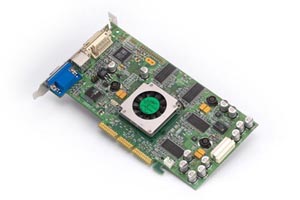 The company has launched the production of graphic cards based on ATI Radeon 8500, 7500, 7000 (RX series: RX-85, RX-75, RX-70, cards respectively), on SiS315 (VX series: VX-3150 and VX-3200), but the most interesting is the VINIX's SiS Xabre line: VX-3360 (Xabre 600), VX-3340 (above, Xabre 400), VX-3320 (Xabre 200), and VX-3300 (Xabre 80). The novelties are to be presented at Computex 2002. Displays
Huge analytical materials concerning TFT LCD price dynamics, posted in May, show that the market is currently absorbed by a rather difficult situation in this sector. On the other hand is the noticeable deficit of LCD panel deliveries resulting in the wholesale release prices growth. On the other is the launch of new production lines and analysts warning of possible overstocking at the end of the year along with the display prices reduction. Well, let's leave these forecasts for news blocks and research articles. I guess it'll be enough to mention completely loaded production lines and almost every manufacturer planning to double production capacity in the nearest half-year. The general trend of market segmentation according to the home country grows stronger. While Japanese LCD panel manufacturers re-equip facilities for hi-tech mobile phone screens and OLED technologies, their South Korean rivals specialize in producing larger-inch LCD panels. Taiwanese companies feel great, releasing mostly monitor and notebook LCD panels. Some analysts believe that price growth might lead to quick LCD panel demand reduction. Why quick? It's simple: CRT monitor prices are now catastrophically low, becoming the alternative while TFT LCD maker get their prices normal again. The message from LG.Philips about launching the world-first facility for production of 5-generation LCD panels (substrates more than a meter large). P4 fab in Cumi, South Korea will produce 15" and 18" panels for monitors, 15" panels for notebooks, 18" and 25" wide-format digital TV panels. Now the capacity of P4 is 30 thousands substrates (1000 x 1200 mm) per month. In the second half-year of 2002 P4 will reach planned production capacity and will produce up to 60 thousands substrates per month. The launch of a close-feature 5-generation Samsung's fab is planned to the 4th quarter of 2002 I guess the most interesting technological event of display manufacture sector was the Toshiba's announcement of flexible Low-temperature Polysilicon LCD displays. 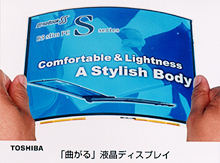 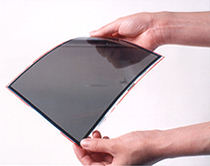 Full-color samples presented were 8.4" in diagonal, supporting SVGA resolution (800 x 600). The announced thickness of panels is very interesting as well, as it was less than 0.4 mm at the about 20 gr weight. New displays can be folded to any angle, radius of curvature being up to 20 cm. I'd also like to mention 21.3" SyncMaster 210 LCD display ($2250) from Samsung. 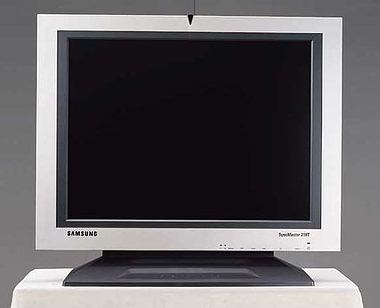 It supports 1600 x 1200 (UXGA); pixel size: 0.27 mm, contrast: 500:1, maximum brightness: 230 candles/sq. m, response time: 25 ms. The model features analog and digital DVI-D, composite AV-In, removable dynamics (2 x 5 W). It also support Picture-in-Picture (PIP) mode. Interesting was the release of 18.1" SDM-X82 and 15" SDM-X52 in the SDM-X series from Sony. 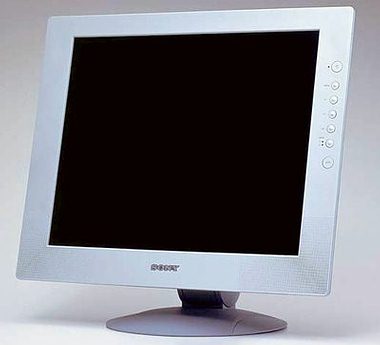 SDM-X82 ($990, amorphous silicon) has 1280 x 1024 max. resolution. Viewing angle is 160 degrees vertically and horizontally, max. brightness: 300 candles/sq. mm, contrast: 350:1, response time: 20 ms (white -> black) and 30 ms (black -> white). 15" SDM-X52 ($490, amorphous silicon) has 1024 x 768 max. resolution, Viewing angle is 120 degrees horizontally and 90 vertically, max. brightness: 300 candles/sq. mm, contrast: 300:1, response time: 10 ms (white -> black) and 20 ms (black -> white). Another two interesting LCD novelties from BenQ, deliveries starting in June: 20.1" FP2081 featuring UXGA (1600 x 1200) resolution and 18.1" FP882 featuring SXGA (1280 x 1024) resolution. FP2081 ($1500) has analog, digital DVI-D and S-video inputs, supports picture-in-picture, (PIP). Contrast: 350: 1, max. brightness: 250 candles/sq.m, pixel size: 0.255 mm, response time: 25 ms. 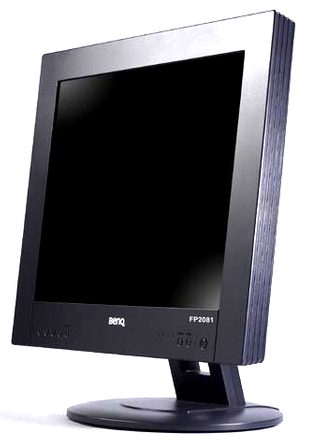 FP882 (on the photo; about $980) has analog and digital DVI-D inputs, built-in stereo dynamics, 2-port USB hub. The panel contrast is 350:1, max. brightness is 250 candles/sq.m, pixel size is 0.2805 mm, response time: 50 ms. Notebooks
As there were no mobile processors announced in May, it brought only portables on the previous chips along with new "surprise-everybody" concepts and variations. Though a new chipset or just graphics can be enough for manufacturers to begin developing new solutions. The appetite comes with eating. After gaining positive experience of mobile Pentium 4 usage, some makers started planning to use new Intel's desktop integrated chipsets: 845GL and 845GLL in their medium and low-end notebooks. The reason is simple: the set of currently discrete mobile i845MP chipset with additional graphics from ATI costs $65 ($35 + $30), i845MZ supporting 533 MHz FSB, expected soon, will cost $37. At the same time integrated i845GL costs about $25, and the 845GLL version (with "older" ICH2 South bridge) is even cheaper: $20. It's the noticeable economy, isn't it? Even the installation of additional LVDS (low voltage differential signaling) and TMDS (transmission minimized differential signaling) chips will cost just $5-7 per unit, being still more profitable. Such converter chips are already being produced by Chrontel from USA. According to messages from Taiwan, Dell Computer, Hewlett-Packard, and Toshiba are very interested with these solutions. The first models based on i845GL are expected in the second half-year. By the way, there are no other mobile chipsets expected in the nearest future: the next mobile integrated chipset from Intel - Montara GML - is to appear only in the first quarter of 2003, according to the roadmap. Some exotics announced in May: the concept design of Tablet PC from Via Technologies. 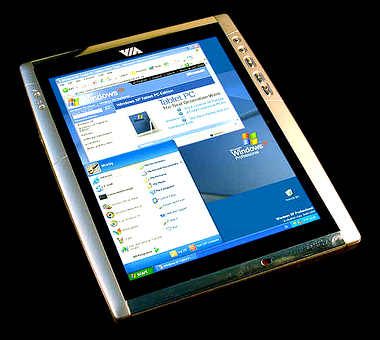 VIA Tablet PC is a stylish ultraslim (less than an inch) portable PC weighing about 1 kg, featuring 10.4" LCD display and digital ink technology support. It's based on VIA C3 or VIA Eden ESP and the special double-sided VIA Apollo 2002 motherboard with Apollo Pro266T chipset supporting DDR SDRAM. The model is equipped with 6-channel audio, USB 2.0, 1394 (VIA Fire II VT6306) interfaces, wireless 802.11b, PCMCIA slot, VIA Tahoe VT6103 LAN port, pre-installed Windows XP Tablet PC Edition. I'd also like to mention the professional Dell Precision Workstation M50 (from $3300).  It's interesting as it's the first workstation using on NVIDIA Quadro 4 500 Go GL (64 MBytes VRAM) chip. The model is based on 1.8 GHz Mobile Pentium 4-M, i845MP chipset, features 15" UXGA (1600 x 1200) Dell Ultrasharp display, up to 1 GB DDR SDRAM, 80 GBytes Ultra-ATA/100 HDD, IEEE1394 ports, S-video, V.56kbps modem, integrated antenna for wireless LAN adapter, optical drive.  Sony, continuing it's general "comfortable work anywhere" line, announced some unusual VAIO PCG-NV170 notebook ($2200), featuring not only CD-RW drive and music creation editing software, but also a subwoofer, inserted into the floppy drive bay. The notebook, packaged into the three-component case, is equipped with 15" display, 1.6 GHz Intel Pentium 4-M, 256 MBytes RAM, 30 GBytes HDD, CD-RW and floppy drives. Other models with more powerful CPUs, more memory and wireless interfaces will be sold by Sony at its web-site. VAIO PCG-NV170 is promoted as a complete replacement to a desktop PC. Despite this subwoofer model is far not the first on the market, Sony believes in a good sales volume due to its highly advertised trademark. Let me also mention the release of ultraslim Dell Latitude X200 (from $1899) based on 800 MHz ULV PIII-M.  Latitude X200 is just 20 mm thick, it weighs slightly more than 1 kg. The notebook features 12.1" 1028 x 768 (XGA) display, 800 MHz Ultra Low Voltage Mobile Intel Pentium III-M CPU, i830MG chipset, 30 GBytes ATA-100 HDD, integrated 56K V.92 modem, 3Com 10/100 Ethernet adapter, two USB ports, an IEEE1394 port, PC Card slot; up to 640 MBytes of PC133 SDRAM is supported. There are not many notebooks based on AMD processors, still the announcements appear in the news from time to time. In May Compaq, now being the part of Hewlett-Packard announced the Evo Notebook N115 (from $1150) based on 1.2 GHz Mobile Duron. 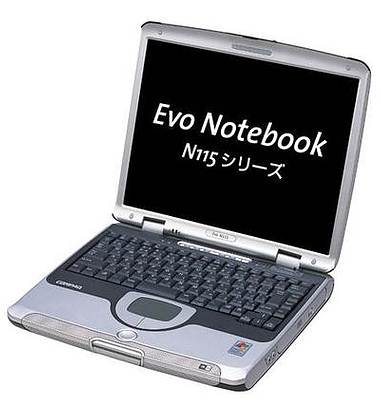 Evo Notebook N115 bases on VIA ProSavage KN133 chipset and is equipped with 14.1" 1024 x 768 (XGA) TFT matrix, 128 MBytes SDRAM (up to 384 MBytes), 20 GBytes HDD, FDD, 24x CD-ROM drive, 56kbps modem, 100base-TX/10BASE-T LAN adapter, etc. To my surprise I found a B5 design notebook from a not so usual manufacturer - Iiyama - among many Crusoe TM5800 based novelties of May. 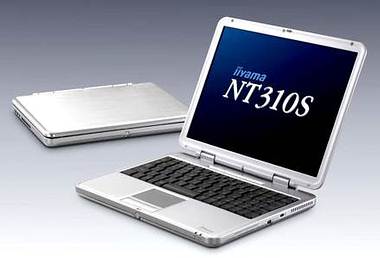 Iiyama NT310S ($1150) has 800 MHz Crusoe TM5800 CPU, ALi M1353 chipset, ATI RAGE Mobility M1 graphics (PCI, 8 MBytes of built-in memory). It also features 12.1" 1024 x 768 (XGA) LCD matrix, 256 MBytes PC133 SDRAM, 20 GBytes UltraATA/66 HDD, USB 2.0, IEEE1394 ports, integrated LAN (10/100BASE-TX) controller and 56kbps V. 90/K56flex modem, Video-Out and PC Card Type II slot. Apple also acted in May, having released some portable novelties: iBook (up to $1799) on 700 MHz PowerPC processors. 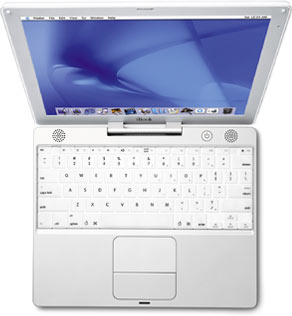 A typical model features: 700 MHz PowerPC G3 CPU with 512 KBytes L2 cache, 14.1" TFT panel, 256 MBytes SDRAM, 30 GBytes Ultra ATA HDD, DVD-ROM/CD-RW combo. MultimediaThere were not many multimedia novelties in May, still they were "on business". Among new sound cards I'd like to mention 5.1-channel Gamesurround Muse 5.1 DVD ($30) from Hercules announced in the middle of the month.  The novelty is actually the newer version of popular Gamesurround Muse XL. It bases on CMI-8738 LX audio processor and supports full-duplex 16-bit mono/stereo 4 kHz - 48 kHz mode. Sensaura 3D engine enables to speak of compatibility with Microsoft DirectSound 3D, EAX 1.0, EAX 2.0, A3D 1.0, I3DL2, MacroFX, MultiDrive, ZoomFX, EnvironmentFX. It also supports Microsoft DirectSound & DirectMusic, Dolby Surround, Dolby Digital, MIDI - GM. The card has three independent stereo outputs for plugging-in 6 dynamics (front, rear, Center/LFE), Mic-In, stereo Line-In, game port/MIDI MPU-401 inputs; CD-in, Aux-in sockets onboard. The card will be packaged with a popular Cyberlink PowerDVD 4.0 XP player, Acid Xpress editor from Sonic Foundry and Hercules MediaStation II multimedia player. In May TerraTec reported the sales of 5.1-channel SoundSystem DMX 6fire LT card, the lite version of popular SoundSystem DMX 6fire 24/96.  DMX 6fire LT is based on EWX/EWS88 and is a complete 24-bit/96 kHz solution. External MXR module, plugged into the free backpanel slot, provides optical digital In/Out and a Mic-In. Below are the specs in brief:
There was not much new acoustics in May as well. In the middle of the month there were messages about the announcement of new WAVIO GX-D90 ($150) stereo system from Onkyo. 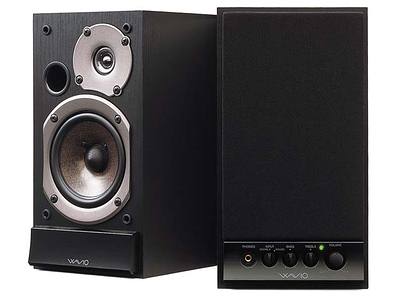 GX-D90 features two double-band dynamics with built-in digital-to-analog coder and amplifier, analog and digital S/PDIF input (optical/coaxial). The digital-to-analog coder path features additional VLSC (Vector Linear Shaping Circuitry) chip like all the latest company's cards. GX-D90 features 15 +15 W (4 ohm) output power, 48 Hz - 90 kHz frequency range; 24-bit 32/44.1/48/96 kHz mode support; subwoofer and headphones jacks. At E3 Expo 2002 Altec Lansing has at last officially presented its first 5.1-channel systems. One is 251 of 200 series, also featuring 2-piece 220 basic level system ($30) and 3-piece (two satellites + subwoofer) 221 system ($50) with 50 W of total power.  5.1-channel 251 system ($100) with 90 W total power (45 W RMS) has 5 satellites and a subwoofer with the 5.25" diffuser. The central satellite can be easily mounted onto the monitor. The controls (power on/off, mode indicators, central channel volume controls, surround and general) are located in the right front satellite. The company also presented the Altec Lansing XA Video Game budget line for using with game consoles, PCs, TVs, DVD players. The line features 1-piece XA 3001 system/subwoofer ($50) for TV (up to 30 W); 3-piece system of two satellites and a subwoofer - XA 3021 ($100) with up to 40 W total power. A wired remote control is included. 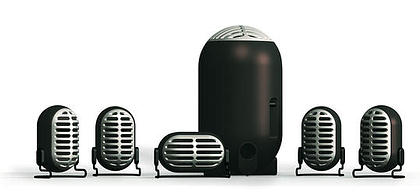 The most interesting is the 5.1-channel XA 3051 system ($200) with up to 100 W of total power, supporting Dolby Surround Pro Logic. And at the very end let's mention the Creative's surprising device - PS2/MIDI Prodikeys keyboard ($99). 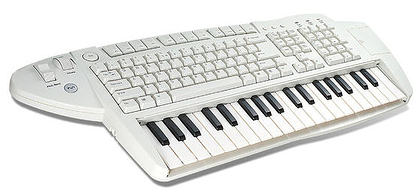 Creative Prodikeys combines the features of 37-key MIDI and QWERTY computer keyboard. The Quick Access octave switch enables to virtually extended 37 MIDI keys to 109. Creative Prodikeys is supplied with special software, enabling a user to set various key combinations for comfortable working in music editors. Using the keyboard with Sound Blaster Live! or Sound Blaster Audigy, enables the E-mu SoundFont technology support. Write a comment below. No registration needed!
|
Platform · Video · Multimedia · Mobile · Other || About us & Privacy policy · Twitter · Facebook Copyright © Byrds Research & Publishing, Ltd., 1997–2011. All rights reserved. |